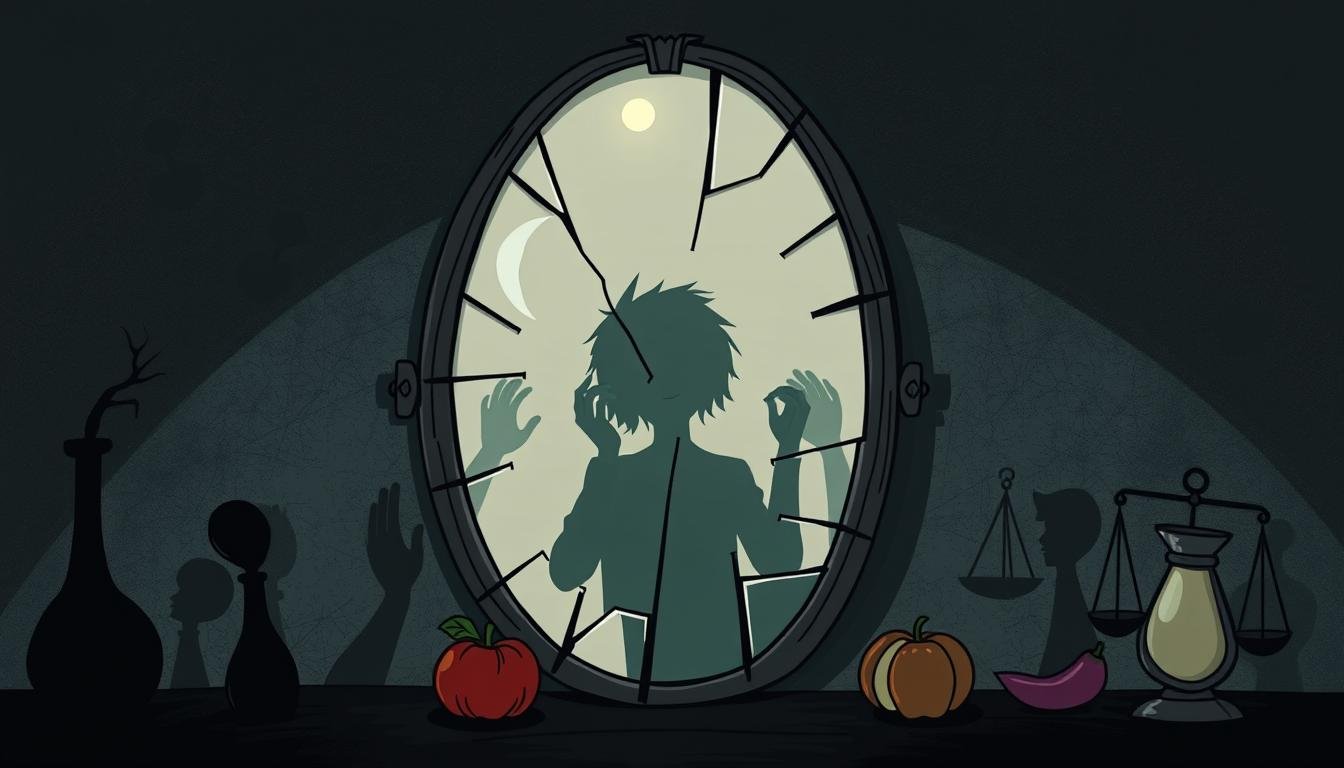Understanding Eating Disorders: Symptoms & Support
Have you ever wondered why some people’s relationship with food becomes a life-threatening battle? Eating disorders are more than just extreme diets or picky eating habits. They are serious mental health conditions that can affect anyone, no matter their age, gender, or background.
Anorexia nervosa and bulimia nervosa are the two most common eating disorders. They often start during the teenage years. These conditions can have severe effects on both physical and mental health. For example, anorexia has a high death rate, with starvation and suicide being major causes.
Eating disorders don’t just affect how we eat and see our bodies. They are often linked to other mental health issues like depression, anxiety, and substance use disorders. The impact can be wide-ranging, affecting relationships, daily life, and overall well-being.
Treatment for eating disorders is complex but crucial. Family-based approaches have shown promising results, especially for younger patients. While there’s no one-size-fits-all solution, understanding the symptoms and seeking support early can make a significant difference in recovery.
What Are Eating Disorders?
Eating disorders are serious mental health issues that affect millions globally. They involve abnormal eating habits that harm both body and mind. Up to 5% of people deal with eating disorders, mostly in teens and young adults.
Definition and Misconceptions
Eating disorders are more than just about food and weight. They are complex, influenced by biology, psychology, and society. Many think they only affect young women, but they can affect anyone, at any age or background.
Common Types of Eating Disorders
The most common eating disorders are:
- Anorexia nervosa: Severe food restriction and unhealthy low body weight
- Bulimia nervosa: Binge-eating followed by purging
- Binge eating disorder: Consuming large amounts of food repeatedly
- ARFID (Avoidant/Restrictive Food Intake Disorder): Extreme food limitations, often starting in childhood
Impact on Physical and Mental Health
Eating disorders can severely harm both body and mind. They often come with other mental health issues like depression and anxiety. Anorexia nervosa has a high death rate, second only to opioid use disorder.
Physical problems include osteoporosis, heart issues, and organ failure.
“Eating disorders are not a lifestyle choice. They are serious mental health conditions that require professional help and support.”
Getting help early can greatly improve recovery chances. If you or someone you know has disordered eating, seek professional help quickly.
Anorexia Nervosa: A Closer Look
Anorexia nervosa is a serious eating disorder that causes extreme weight loss and a wrong view of the body. It can affect anyone, but it’s more common in teenagers.
Key Symptoms and Behaviors
Self-starvation is a key sign of anorexia. People with this disorder often diet too much and exercise too much. They feel they’re never thin enough, even when they’re very underweight. About one-third to one-half also binge and purge.
Physical Consequences
Anorexia has a big impact on the body. It can cause:
- Anemia
- Heart conditions
- Bone loss (osteoporosis)
- Muscle loss
- Stomach problems
- Kidney issues
- Hormonal imbalances
Anorexia is very dangerous. It has the second-highest death rate of any mental illness, after opioid overdoses. Most deaths are from heart problems or suicide.
Psychological Aspects
Body dysmorphia is a big part of anorexia. People with this disorder see themselves as overweight, even when they’re very thin. It’s also linked to perfectionism, low self-esteem, and obsessive thoughts about food and weight.
| Risk Factors | Impact |
|---|---|
| Genetic predisposition | Increased likelihood of developing anorexia |
| Weight-related teasing or bullying | Higher risk of eating disorders |
| Dieting behaviors | Elevated risk of anorexia |
| Major life changes | Can trigger onset of anorexia |
It’s important to know these signs and risk factors. This helps with early treatment and recovery from anorexia nervosa.
Bulimia Nervosa: Understanding the Cycle
Bulimia nervosa is a complex eating disorder. It involves a binge-purge cycle. This cycle means eating a lot of food quickly and then doing things to avoid gaining weight.
The binge-purge cycle often starts in the teen years. It can last into adulthood if not treated. Many people don’t get help until their 30s or 40s. Bulimia affects both males and females, but more girls and women of color are affected.
“Dieting doubles the risk of developing an eating disorder.”
Bulimia can cause serious health problems. These include electrolyte imbalance, heart issues, and dental erosion. The constant cycle of bingeing and purging can harm the body’s balance and organs.
- Heart problems
- Dental issues
- Kidney problems
- Digestive problems
- Skin and hair issues
Treatment for bulimia includes cognitive-behavioral therapy. It helps change behaviors and address nutritional issues. In severe cases, hospitalization may be needed to manage electrolyte imbalances. Early treatment is crucial to avoid long-term health problems.
If you or someone you know is struggling with bulimia, call the National Alliance for Eating Disorders helpline at 866-662-1235. They offer support and resources.
Binge Eating Disorder: More Than Overeating
Binge Eating Disorder (BED) is more than just eating too much. It’s a serious issue where people eat a lot of food quickly, often feeling uncomfortable. Unlike other eating disorders, those with BED don’t try to make up for it after eating a lot.
Distinguishing Features
BED is marked by a lack of control during eating, followed by shame or guilt. It affects about 1.6% of adult women and 0.8% of adult men in the U.S. It usually starts in late teens or early twenties, with more women affected.
Health Risks Associated with BED
BED can cause obesity and serious health problems. These include:
- Type 2 diabetes
- Heart disease
- Joint problems
- Gastroesophageal reflux disease (GERD)
- Sleep-related breathing disorders
Emotional and Social Impact
BED’s effects go beyond physical health. It can lead to emotional eating, depression, and anxiety. People with BED often feel embarrassed about their eating habits, leading to social isolation. This can make them feel worse about themselves, starting a cycle of binge eating.
Treatment for BED aims to tackle both physical and emotional issues. Cognitive Behavioral Therapy (CBT) is effective, and medications like Lisdexamfetamine help with impulse control. Remember, BED is a serious condition that needs professional help, not just willpower.
Eating Disorders: Risk Factors and Causes
Eating disorders come from a mix of factors. Research shows genetics play a big role. People with family members who have eating disorders are more likely to get one too. This shows how important family history is in assessing risk.
Sociocultural influences also play a big part. A review of 284 studies found key risk factors. These include body image concerns and social media use. Being in education or sports that focus on looks can also make someone more vulnerable.
Trauma and abuse are linked to eating disorders. Childhood experiences, like obesity, can have lasting effects. Mental health issues often make eating disorder symptoms worse, creating a tough cycle for those affected.
- Anorexia affects up to 1% of women in the US
- Binge eating disorder impacts 3.5% of women and 2% of men
- Bulimia affects 1-2% of young women
While women face higher risks, men are not safe. Muscle dysmorphia is a disorder that affects some men. Age also matters, with teenagers and young adults most at risk. But eating disorders can happen at any age.
“Eating disorders arise from a complex interplay of genetic, biological, psychological, and sociocultural factors.”
Understanding these diverse risk factors is key for early help and treatment. By seeing the many sides of eating disorders, we can tackle their causes better. This way, we can offer full support to those affected.
Treatment Approaches for Eating Disorders
Eating disorders need a treatment plan made just for each person. These plans mix different therapies, medical care, and nutrition advice. They help with both physical and mental health.
Psychotherapy Options
Talk therapy is key in beating eating disorders. Cognitive-behavioral therapy (CBT) works well for bulimia and binge-eating. The Maudsley Model of Treatment for Adults with Anorexia Nervosa (MANTRA) is also effective for anorexia.
Family-based treatment is great for teens. It involves parents in the recovery process. This helps a lot.
Medical and Nutritional Support
Medical checks are crucial because eating disorders can be very dangerous. Sometimes, hospital care is needed. Registered dietitians play a big role in treatment, teaching healthy eating habits.
Antidepressants are often given, especially for bulimia or binge-eating disorder. This helps manage symptoms.
The Role of Family in Treatment
Family support is very important, especially for young people. Family-based treatments work well, with parents helping a lot. This creates a supportive home environment, key for long-term recovery.
Source Links
- Eating Disorders: What You Need to Know
- Understanding Eating Disorders, such as Anorexia and Bulimia
- Eating Disorders
- What are Eating Disorders?
- Eating disorders – Symptoms and causes
- Signs of Eating Disorders: Types and Symptoms
- Anorexia nervosa – Symptoms and causes
- Bulimia Nervosa
- Understanding Bulimia | JED
- Binge-eating disorder – Symptoms and causes
- Binge Eating Disorder
- Overeating vs. Binge Eating Disorder: What is the Difference?
- Risk factors for eating disorders: findings from a rapid review – Journal of Eating Disorders
- Causes and Risk Factors for Eating Disorders
- Eating disorder treatment: Know your options
- Treatment Approaches for Eating Disorder Recovery
- Psychological Treatments for Eating Disorders








